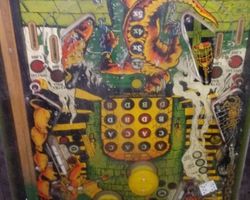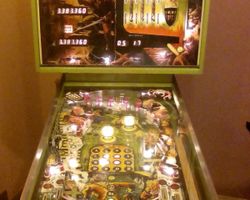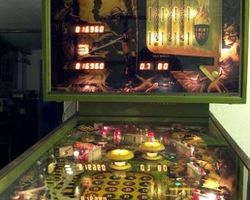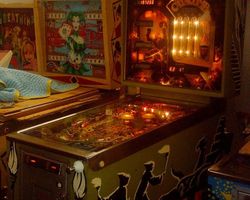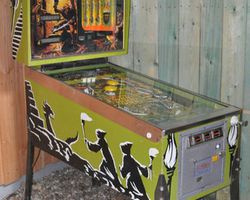Catacomb
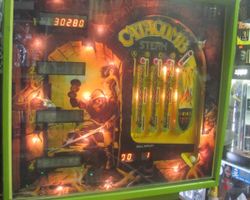
Average Prices: USD $200 to $1,300
Produced: October, 1981
Machine Type: Solid State Electronic
MPU: Stern M-200 MPU
Players: 4
Design by: Joe Joos Jr.
Art by: Larry Day
"Catacomb," released in October 1981 by Stern Electronics, Inc., emerged as a distinctive entry in the solid-state electronic pinball era. Designed by Joe Joos Jr., with captivating artwork by Larry Day, this Model 147 machine invited players into a world of fantasy, monsters, and science fiction. Its creation marked a period where pinball designers pushed the boundaries of mechanical and digital integration, aiming for deeper, more intricate gameplay experiences. The production run of "Catacomb" was not as extensive as some of its contemporaries, contributing to its current desirability among collectors seeking a unique piece of early 1980s pinball history. It stands as a notable example from Stern's M-200 MPU generation, reflecting the evolving sophistication of electronic pinball machines. A curious detail from its production run is the existence of two distinct playfield versions: one with numbered drop target inserts and another with lettered inserts, a minor variation that offers a point of interest for keen observers. Its marketing tagline, "A chilling game of skill," succinctly captured the essence of its challenging nature.
Signature Features and Design
"Catacomb" immediately distinguishes itself through its striking visual and mechanical elements. Larry Day's artwork is a consistent highlight, often described as a masterpiece for its detailed depiction of robed figures, fantastical creatures, and a dungeon-crawl aesthetic. The pervasive "Stern green" on the cabinet grounds the machine in its era, while the vibrant playfield art draws players into its thematic world. The cabinet itself, often noted for its "split peas soup" hue, provides a unique visual footprint that sets it apart.
However, the most recognized and debated signature feature is the mechanical backbox animation. This is not merely a static display but an active part of the game, featuring a mini-playfield with a third flipper. This innovative "bagatelle" element integrates directly into the primary gameplay, offering a unique opportunity to influence the outcome after a ball enters a specific kick-out hole on the main playfield. This feature, alongside the custom speech synthesis, pushed the envelope for player engagement beyond the main playfield, adding a layer of depth and surprise that few machines of its time offered. The game also features a high count of drop targets—twelve in total, arranged in four banks of three—which become a central element of playfield interaction and scoring strategy. Complementing these are two captive balls and a spinning target, all contributing to the machine's dynamic and visually rich presentation.
Playfield and Mechanics
The "Catacomb" playfield is meticulously designed for rapid-fire action and strategic shot-making. At its core, the layout features two main flippers at the bottom, providing the primary means of ball control. The playfield is dominated by its four 3-bank drop targets, positioned strategically to demand precise aim. Clearing these banks is not just about points; it often advances various scoring objectives or lights features for higher rewards. Above these targets, two pop bumpers animate the upper playfield, sending the ball ricocheting into unpredictable paths. Three slingshots further amplify the chaotic energy, particularly in the lower playfield, where the ball's trajectory can be dramatically altered.
Specific targets include a single spinning target, often considered a high-value shot due to the points it can accumulate rapidly. A standup target and a star rollover complete the array of primary interaction points. Two kick-out holes serve crucial roles, with one leading directly to the backbox bagatelle, a defining mechanical feature. The ball locks in "Catacomb" are notably unconventional; there are no direct shots to lock a ball. Instead, locks are often achieved through indirect means, such as fortunate deflections off pop bumpers or skilled "slop shots," adding an element of accidental discovery and requiring players to adapt to the unpredictable nature of the machine's design. This design choice contributes to a game flow that is constantly active and less predictable than machines with clear, repeatable lock shots. The overall aesthetic of the playfield, with its detailed artwork and thoughtful lighting, complements the dungeon-crawl theme, immersing players in its perilous world. The designers embraced a philosophy of fast, demanding play, expecting players to react quickly and learn the nuances of the layout, including its "greedy outlanes" that demand attentive nudging to keep the ball in play.
Gameplay Dynamics
"Catacomb" offers gameplay dynamics that are both challenging and deeply rewarding for those who invest time in understanding its complexities. The ruleset is considered intricate for its era, a "thinking player's game" that defies a simple explanation but often becomes clearer through hands-on experience. Progression hinges on clearing the numerous drop targets, which are integral to advancing scoring multipliers and bonus features. The game's scoring system is layered, with "toast" numbers or letters on the playfield inserts indicating various bonus levels and objectives linked to target completion.
One of the most intense aspects is the three-ball multiball, an adrenaline-fueled sequence that is difficult to initiate but incredibly satisfying when achieved. Given the lack of direct lock shots, triggering multiball often feels like a triumph of persistence and a little luck. While multiball sequences can be short-lived due to the game's high speed and unforgiving nature, they provide significant scoring opportunities and a surge of excitement. The unique ball lock system adds a strategic layer in multiplayer games, as players can sometimes "steal" locked balls from an opponent, introducing a competitive element.
The backbox bagatelle serves as a unique mode of its own. When the ball enters the designated kick-out hole on the main playfield, it is transported to the backbox. Here, the player uses a third flipper, positioned in the backbox, to interact with a mini-playfield, aiming for specific targets or guiding the ball back to the main playfield. This sequence is not merely a distraction; it can award points, special bonuses, or even extra balls, making it a critical component of high-scoring strategies. While some players find the bagatelle confusing or random, others praise its originality and the skill required to master its timing and ball control. The game demands precise flipper work and quick reflexes, especially with its fast-paced spinner shot, which can accumulate points rapidly and is often considered one of the most satisfying shots on the machine.
Reception and Legacy
Upon its release and throughout the decades, "Catacomb" has garnered a largely positive reception within the pinball community, solidifying its place as a classic solid-state title from the early 1980s. Its strengths are frequently cited: the stunning, detailed artwork by Larry Day consistently receives high praise for its immersive quality and visual appeal. The sheer quantity of drop targets, often referred to as a "drop target bonanza," provides constant action and clear objectives, appealing to players who enjoy precise target shooting. The fast-paced, often brutal gameplay demands quick reflexes and strategic thinking, fostering a sense of accomplishment for those who master its unforgiving nature. The custom speech, a novelty for its time, also adds to the machine's thematic immersion.
However, "Catacomb" is not without its polarizing elements. The primary point of contention often revolves around its backbox bagatelle feature. While many celebrate it as a unique, innovative gimmick that adds depth and a distinct identity to the game, others find it confusing, less skill-based, or disruptive to the main playfield flow. The complexity of its ruleset is another frequently mentioned aspect; new players can find it challenging to grasp the scoring mechanics and objectives, leading to an initial steep learning curve. The unconventional ball lock system, which relies on indirect shots, is either lauded for its ingenuity and added challenge or occasionally seen as frustrating by those accustomed to more straightforward lock mechanisms. Minor criticisms include the "split peas soup" cabinet color, which some find less aesthetically pleasing, and a "steep slingshot feel" in the lower playfield, a characteristic shared with some other vintage Stern machines.
Despite these few points of debate, "Catacomb" holds a strong reputation. It is often considered one of Stern Electronics' finest machines from its era, recognized for pushing the boundaries of mechanical features and gameplay depth in solid-state pinball. Its relative rarity in circulation further enhances its appeal among collectors. The machine's influence can be observed in how it demonstrated that innovative, integrated mechanical features, such as the backbox bagatelle, could significantly enhance the player experience and contribute to the game's overall character. "Catacomb" stands as a testament to the ingenuity of early 1980s pinball design, leaving a legacy as a challenging, visually striking, and uniquely rewarding game that continues to captivate enthusiasts.
Sponsored Links
 Ebay Listings
Ebay Listings
 Auction Results
Auction Results
| Cost | Location | Date |
|---|---|---|
| USD $3,800 |  Kansas, United States Kansas, United States |
11 April, 2025 |
| USD $4,000 |  Florida, United States Florida, United States |
05 August, 2021 |
| USD $4,000 |  Tennessee, United States Tennessee, United States |
14 January, 2021 |
| USD $3,550 |  Minnesota, United States Minnesota, United States |
21 January, 2019 |
| USD $2,000 |  Ohio, United States Ohio, United States |
25 August, 2017 |
| USD $1,600 |  California, United States California, United States |
08 July, 2017 |
| USD $2,050 |  Florida, United States Florida, United States |
01 February, 2017 |
| USD $1,500 |  Arizona, United States Arizona, United States |
30 January, 2016 |
| EUR €605 |  Nordrhein-Westfalen, Germany Nordrhein-Westfalen, Germany |
26 December, 2015 |
| EUR €547 |  Baden-Württemberg, Germany Baden-Württemberg, Germany |
13 February, 2015 |


Private Policy · Search Website · Contact Us
As an eBay Partner, we may earn a commission from qualifying purchases made through links on this site, at no additional cost to you.
All trademarks and copyrighted materials remain property of their respective owners. All other content copyright 2007 - 2025 Pinpedia.

